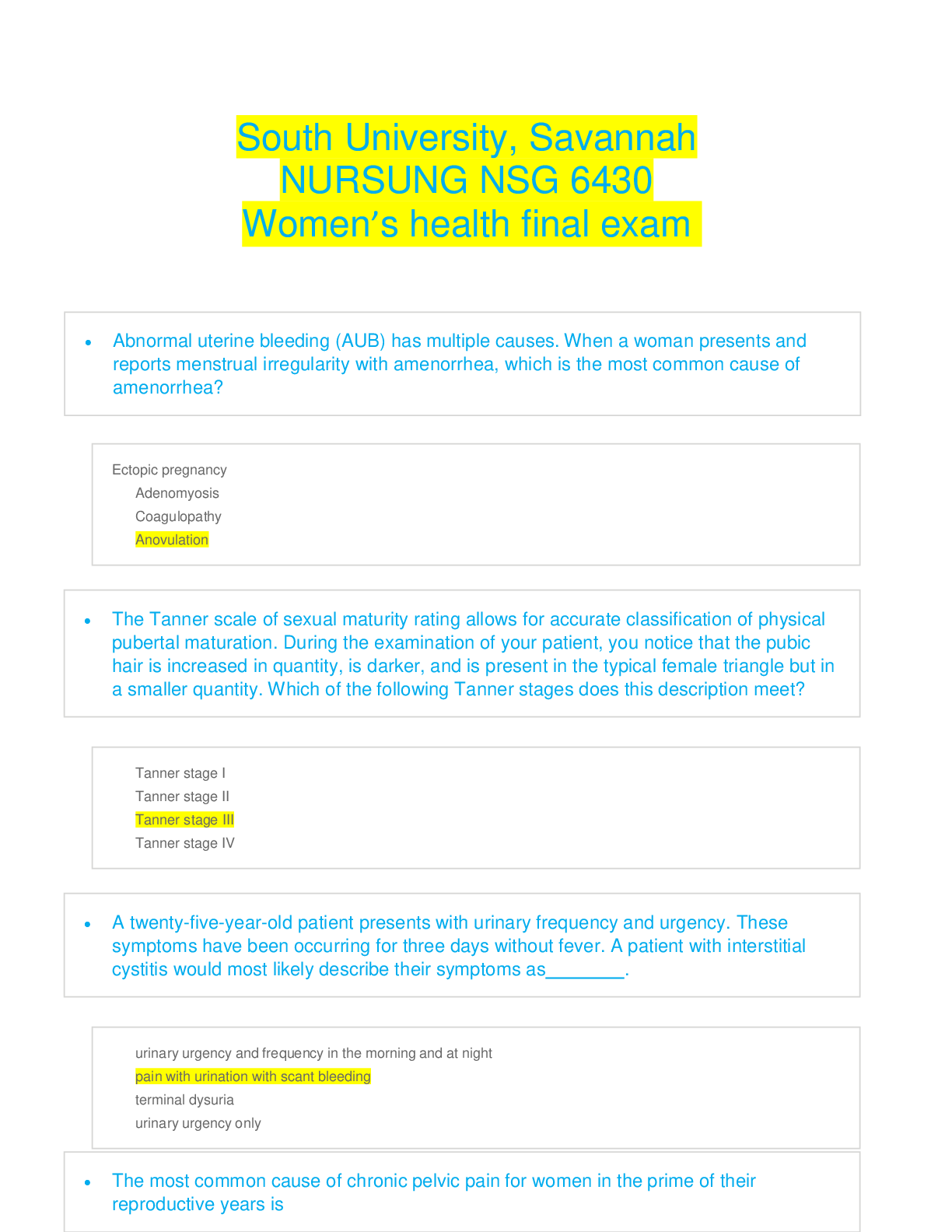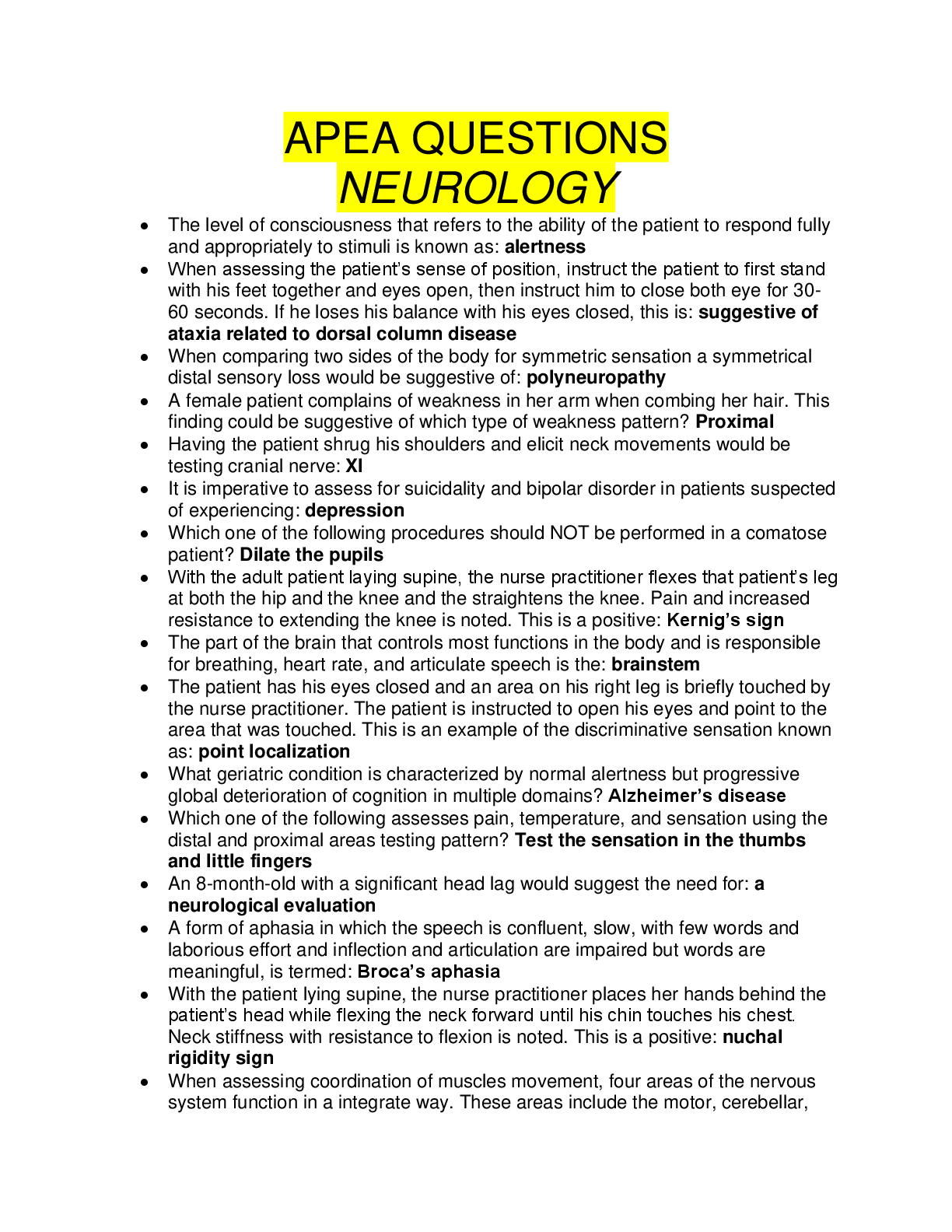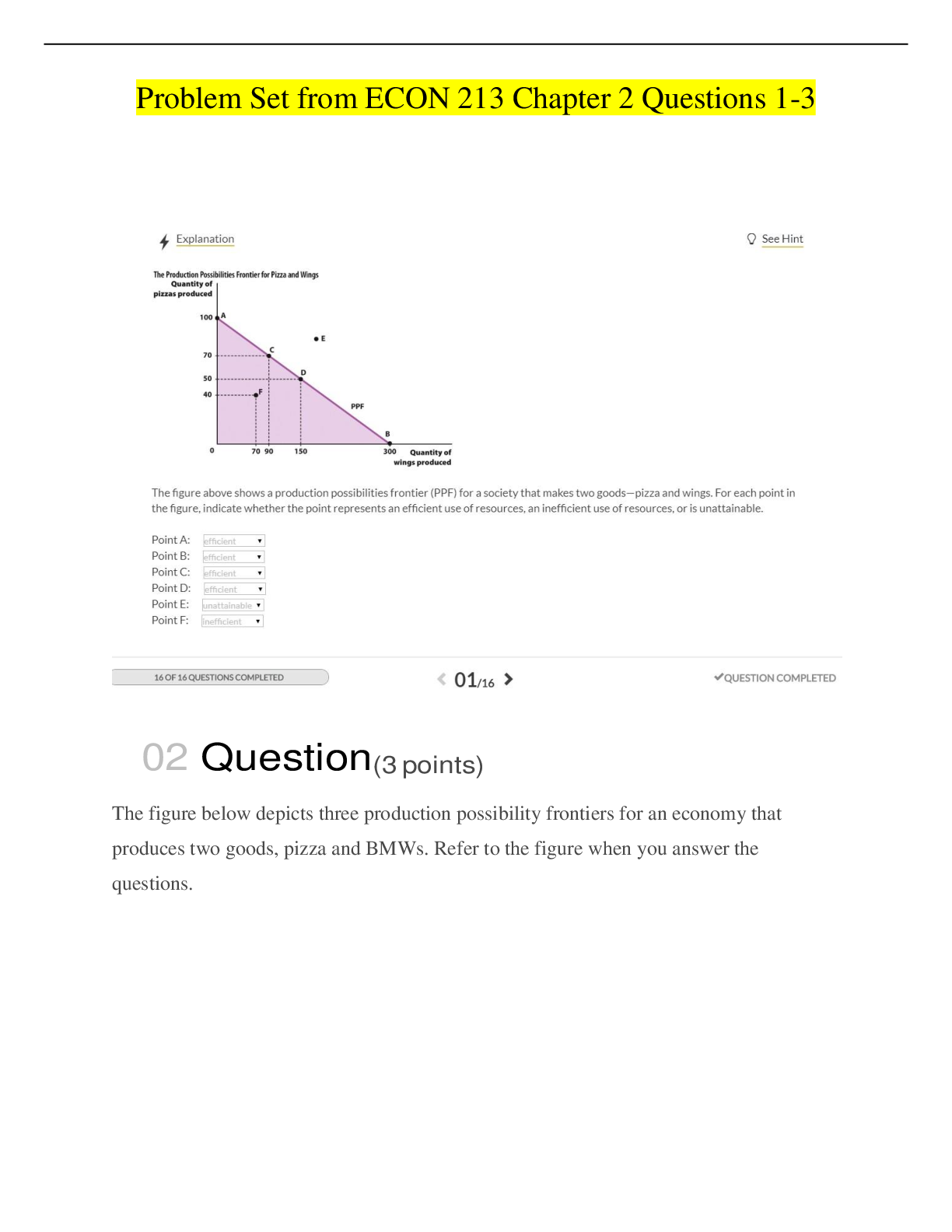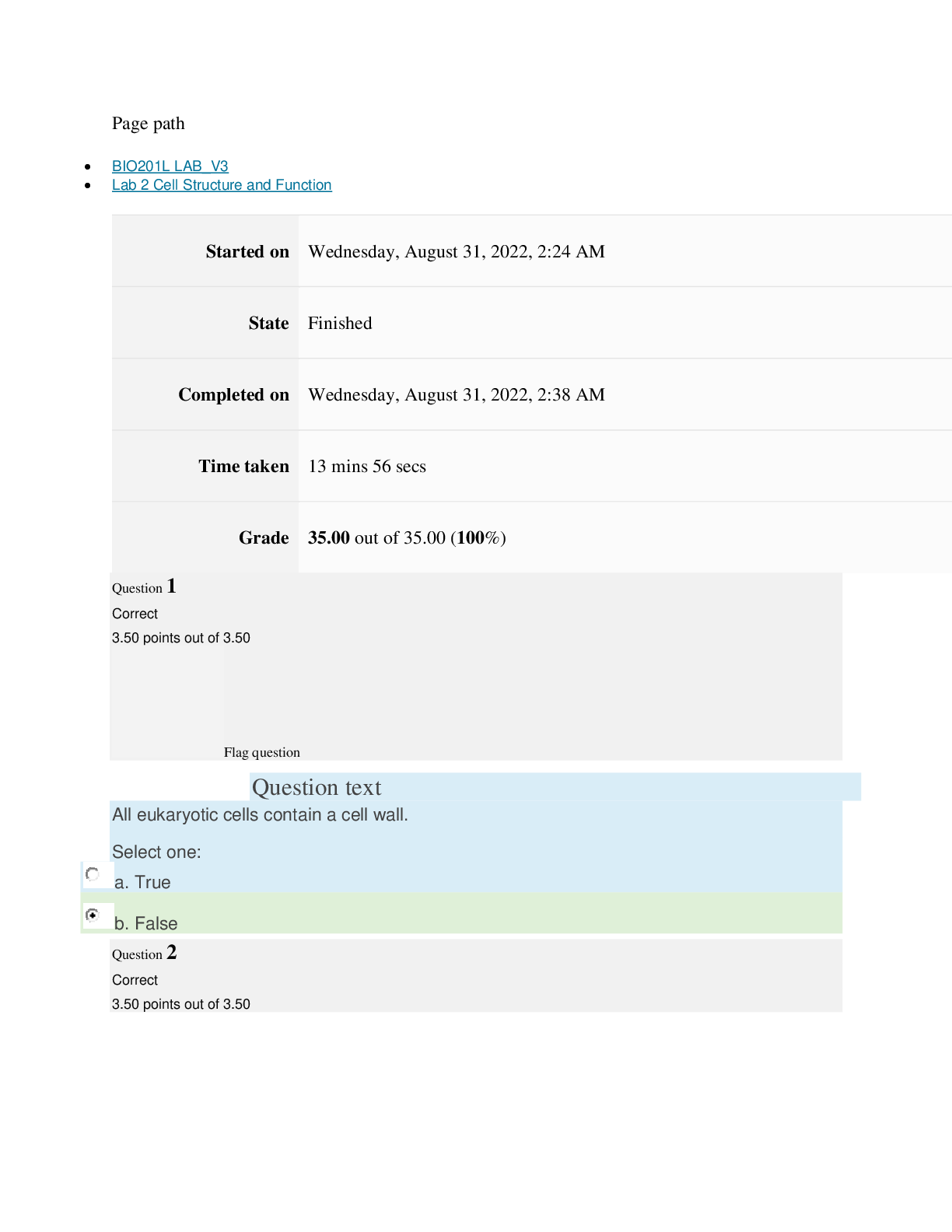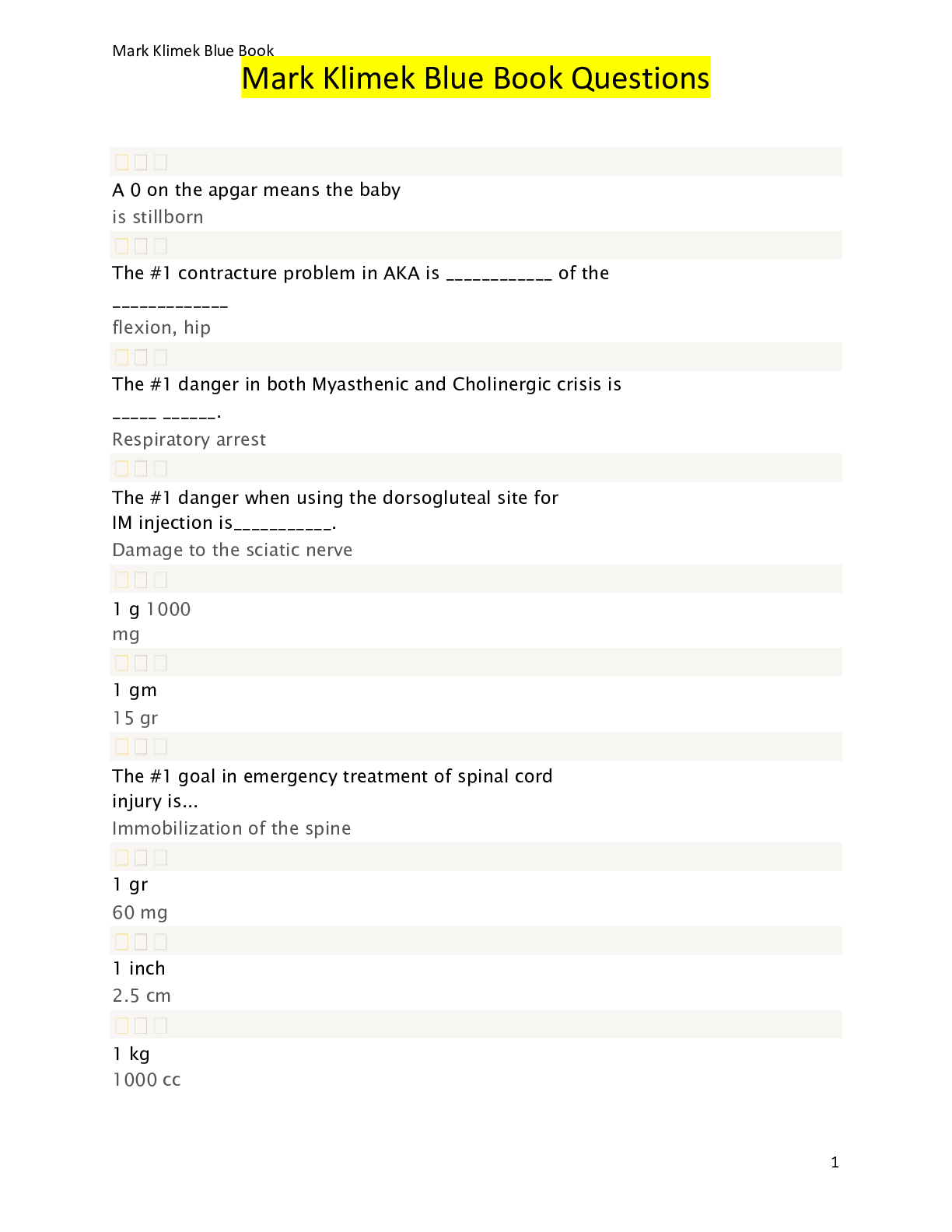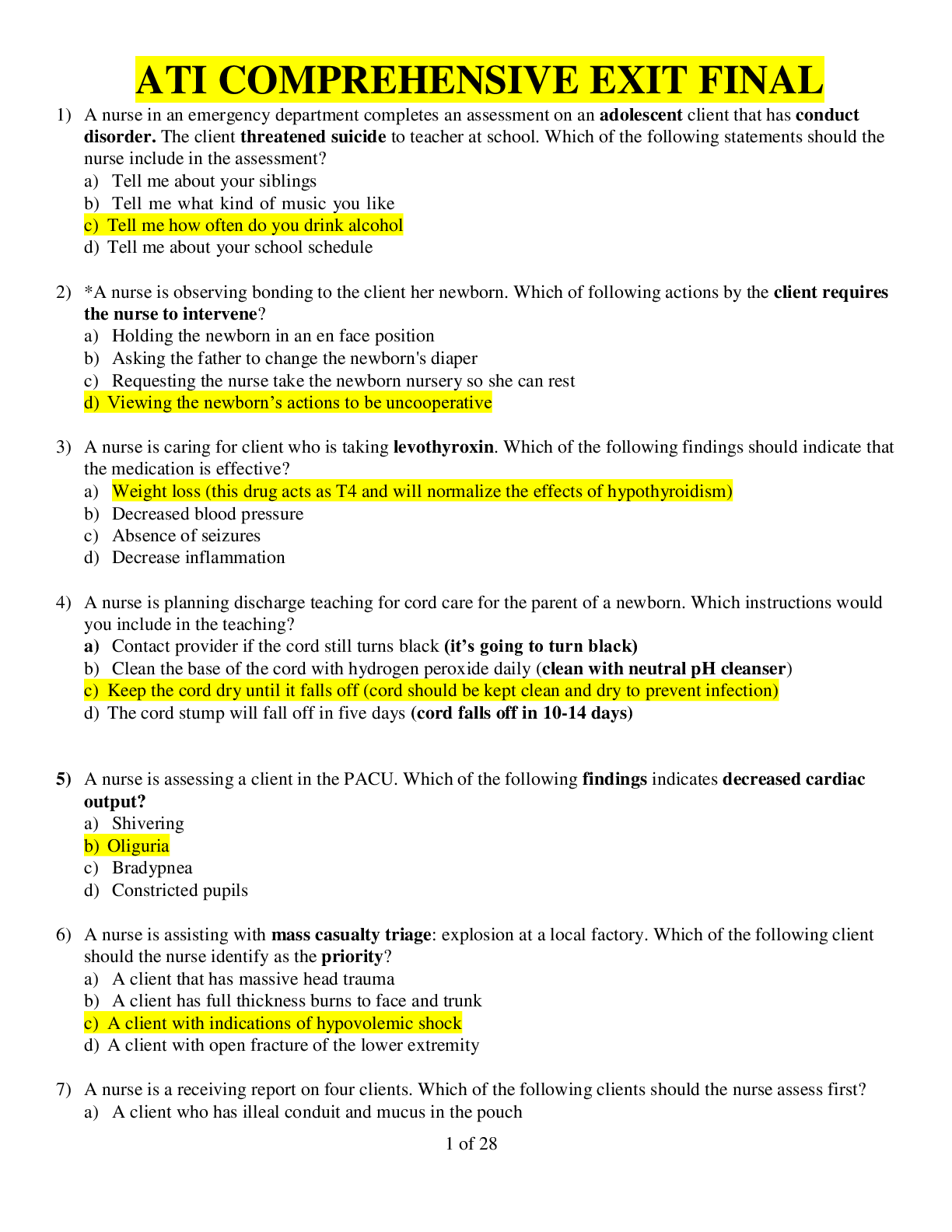*NURSING > QUESTIONS & ANSWERS > AUSTIN COMMUNITY COLLEGE. NURSNG 341. Integumentary Review (GRADED A) (All)
AUSTIN COMMUNITY COLLEGE. NURSNG 341. Integumentary Review (GRADED A)
Document Content and Description Below
NURS 341: Integumentary Review The day following surgery, the nurse notes bloody drainage on the dressing. The nurse will record this drainage as The nurse explains that the advantage of the oc... clusive dressing is that it When the nurse discovers that the gauze dressing has adhered to the wound, the nurse should Because the physician has not ordered a dressing change for a draining wound, the nurse should assess the amount of drainage by When the nurse assesses that blood and fluid flow into the vascular space and produce edema, erythema, heat, and pain, the nurse is aware that the phase of healing is In an attempt to keep the patient comfortable during a dressing change, the nurse may administer an analgesic When there is sustained skin pressure, especially over bony prominences, pressure ulcers may form due to To meet the needs of an unconscious patient with a risk for skin impairment, the nurse will plan to have the patient's position changed every The nurse assesses a red blister over the right superior iliac area and documents this decubitus as a The nursing assessment of a pressure ulcer includes size and depth, pain, odor, and color of tissue in order to evaluate The nurse is attempting to avoid a pressure ulcer for her bedrest patient by turning him every 2 hours and moving him to which favorable position? When providing hand and foot care, the person best prepared to provide nail care for patients with extremely hard nails is the When the nurse discovers a reddened area over the hip, the first assessment should be to When the nurse is collecting a specimen for a wound culture, the specimen should never be collected from A patient has generalized macular-papular skin eruptions and complains of severe pruritus. When the nurse administers his therapeutic bath, it is important to remember that A patient, age 63, has cancer of the left breast. After a modified radical mastectomy, she has been receiving chemotherapy. Her grandson, who visited a few days ago, now has varicella (chickenpox). The nurse should observe her carefully for signs of A patient has herpes zoster (shingles). A local antiinfective agent, which is useful in delaying the progression of herpetic diseases, was prescribed. This medication is A patient has been sent home from work with pruritus and honey-colored crusts on his lower lip and chin. A probable diagnosis would be A patient has an erythematous patch of vesicles on her scalp, and she complains of pain and pruritus. A diagnosis of tinea capitis is made. The causative organism is A patient, age 46, reports to his physician's office with urticaria and papules on his hands and arms. He says, "It itches so badly." In assessing the patient, the nurse should gather data regarding recent A patient has been receiving penicillin, acetaminophen with codeine, and hydrochlorothiazide for 4 days. He now has a urinary tract infection. A sulfonamide has been prescribed to be taken three times per day. Several hours later, he complains of pruritus. The nurse observes a generalized erythema and rash. The most appropriate nursing intervention would be to hold A patient has acne vulgaris. When the nurse explains this condition, it is most important to A 30-year-old African American had surgery 6 months ago. Her incisional site is now raised, indurated, and shiny. This tissue growth is most likely a(n) A patient, age 37, sustained partial- and full-thickness burns to 26% of her body surface area. The greatest fluid loss resulting from her burns will usually occur Most of the deaths from burn trauma in the emergent phase that require a referral to a burn center result from A patient, age 26, is admitted to the burn unit with partial- and full-thickness burns to 20% of his body surface area as well as smoke-inhalation injury. Carbon monoxide intoxication secondary to smoke inhalation is often fatal because carbon monoxide A nurse arrives at an accident scene where the victim has just received an electrical burn. The nurse's primary concern is A patient, age 27, sustained thermal burns to 18% of her body surface area. For the next 72 hours, the nurse will have to observe for the most common cause of burn-related deaths, which is A duodenal ulcer may occur 8-14 days after severe burns. Usually, the first symptom is bright red emesis. Which condition matches this description? A nurse is providing the occlusive method of treatment for a patient who is 52 years old with burns to her lower extremities. It would be important for the nurse to The nurse has initiated measures to promote suppuration of a carbuncle. Which of the following would indicate that these measures have been successful? A patient, age 20, is admitted with severe eczema. In planning the care for her, the nurse should plan to The nurse is caring for a 26-year-old patient who was burned 72 hours ago. He has partial-thickness burns to 24% of his body surface area. He begins to excrete large amounts of urine. The nurse should A patient, age 29, is diagnosed with genital herpes. She is receiving acyclovir (Zovirax). Which of the following would indicate a therapeutic response? A female patient is seen by the school nurse because of flat lesions that are clear in the center with erythematous borders. In assessing a patient for tinea corporis, the nurse would check A patient has been walking in the woods. He complains of severe pruritus. The nurse notes an erythematous area on his lower legs. The first nursing intervention for dermatitis venenata would be to The nurse is débriding a wound. It is important to débride the wound to A patient has been admitted to the hospital with burns to his upper chest. The nurse notes singed nasal hairs. It would be important for the nurse to assess this patient frequently for Which of the following may indicate a malignant melanoma in a nevus on a patient's arm? A dark-skinned patient has been admitted to the hospital in severe respiratory distress. To determine whether the patient is cyanotic, the nurse uses what knowledge of skin assessment? A patient developed a severe contact dermatitis of her hands, arms, and lower legs after spending an afternoon picking strawberries. She states that the itching is severe and she cannot keep from scratching. Which instruction by the nurse will be most helpful in managing the pruritus? A patient is a 32-year-old woman whose mother recently died from malignant melanoma. She asks the nurse about what she can do to prevent the development of malignant melanoma in herself and her children. The best response by the nurse includes which information regarding risk factors for melanoma? If the blood vessels of the skin dilate, the person appears Ceruminous glands Freckles and moles are caused by an accumulation of Which of the following is a consequence of a congenital absence of eccrine glands? Radiation, conduction, convection, and evaporation are terms that are concerned with Hives are called What is the color of skin that is supplied by oxygen-poor blood? Which of the following substances makes the skin water-resistant? What is the result of the contraction of the arrector pili muscles? Which gland is most likely to develop a blackhead or pimple? Which of the following has the poorest prognosis? Anticancer drugs often cause hair loss, a condition called What is the name of the thickening of the epidermis that develops in response to constant pressure or irritation? Melanocytes Cyanosis Apocrine glands To lose heat, flushing is generally accompanied by Shivering Which statement is NOT true of the integumentary system? What structure provides an effective cooling mechanism for the body? During report, the nurse is told that a patient "has moderate jaundice." Which of the following assessment findings would the nurse expect to see? Correct Answer: The epidermis receives its nourishment from what source? . The nurse is applying a medicated plastic wrap dressing to a patient's leg. What intervention should the nurse include in the plan of care to prevent development of complications? The dermis is the ___ layer of the skin and is made of ___ tissue. A 30-year-old African American had surgery 6 months ago. Her incisional site is now raised, indurated, and shiny. This tissue growth is most likely a(n) . The nurse writes two nursing diagnoses: Although the signs and symptoms of both infection and inflammation include erythema, edema, and pain, the major difference is that inflammation The epidermis is the ___ layer of the skin and is made of ___ tissue. Melanocytes produce ___ when stimulated by ___. The functions of the stratum corneum include all of these except: The subcutaneous tissue that stores potential energy is: The primary function of the stratum germinativum is: In a cold environment, the arterioles in the dermis will: Which of these is NOT a function of human hair? Tissues that cover the outside of the body and some internal structures are The nurse notices small purplish dots on the abdomen of a patient. Which of the following demonstrates the best way for the nurse to document the finding? Petechiae are small reddish purple hemorrhagic spots, smaller than 0.5 mm in diameter. Ecchymosis is bruising; erythema is redness; and purpura is bleeding into the skin. Which statement is NOT true of the cutaneous senses? The growth of bacteria on the skin surface is inhibited by: In a warm environment, the arterioles in the dermis will: Drying of the skin and hair is prevented by: Which of the following are classified as sudoriferous glands? (Select all that apply.) B-Eccrine glands D-Ceruminous glands The nurse is caring for a patient in a wound clinic who is treated with plastic wrap dressings. Which of the following findings indicate complications related to prolonged application of the dressings? (Select all that apply.) B-Maceration C-Skin atrophy D-Folliculitis The nurse is caring for a dark-skinned African American patient. In which of the following sites can the nurse best evaluate the presence or absence of cyanosis? (Select all that apply.) : A-Nailbeds B-Soles of the feet Which of the following are functions of the epidermal layers of the skin? (Select all that apply.) A-Provide a barrier against pathogens B-Prevent loss of water and dehydration D-Present foreign antigens to helper T cells E-Prevent entry of excess water into the body Which of the following are functions of the subcutaneous tissue of the skin? (Select all that apply.) A-To destroy pathogens that passed through broken skin C To cushion bones D-To store energy E-To provide insulation from the cold Which of the following are proteins found in the dermis? (Select all that apply.) Answer: B-Collagen C-Elastin Which of the following are normal changes associated with aging? (Select all that apply.) : B-Epidermal cell division slows. C-Hair follicles become inactive. E-Fibroblasts in dermis die. In normal aging, cell division slows, hair follicles become inactive, and fibroblast in the dermis die. Sebaceous and sweat glands become less, not more, active. Subcutaneous fat decreases, not increases. [Show More]
Last updated: 2 years ago
Preview 1 out of 8 pages

Buy this document to get the full access instantly
Instant Download Access after purchase
Buy NowInstant download
We Accept:

Reviews( 0 )
$10.00
Can't find what you want? Try our AI powered Search
Document information
Connected school, study & course
About the document
Uploaded On
Apr 12, 2020
Number of pages
8
Written in
Additional information
This document has been written for:
Uploaded
Apr 12, 2020
Downloads
0
Views
106

